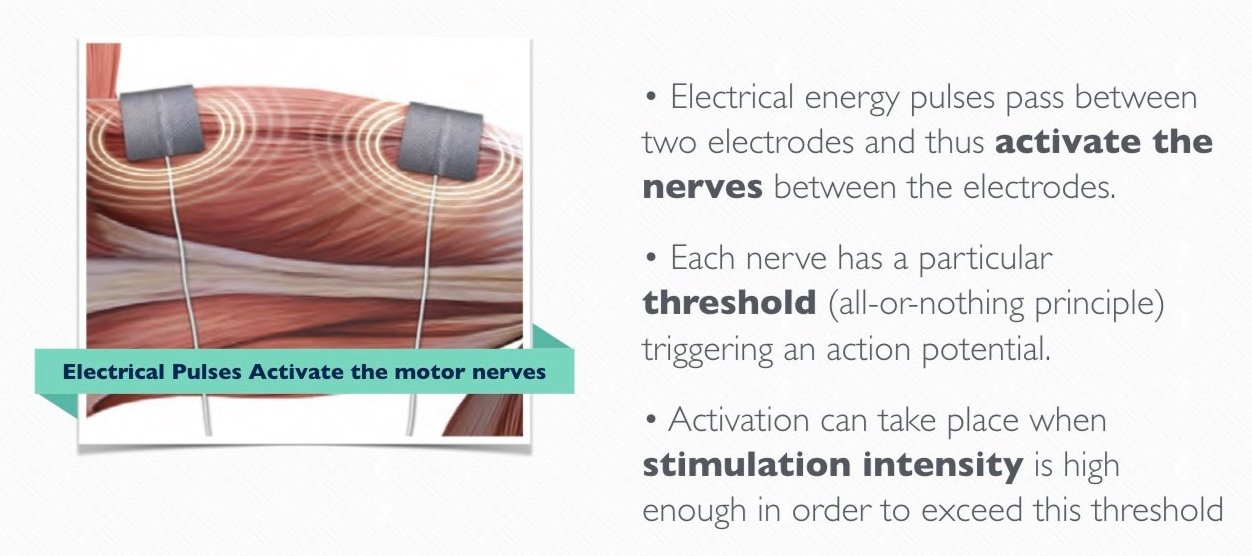How FES Cycling systems are optimised for a user?
FES Cycling is a well-established technique that allows persons with lower limb paralysis, perhaps after a spinal cord injury, to exercise their leg muscles actively despite the paralysis. In this article, we ask how to enhance muscle mass and joint flexibility through targeted electrode placement and a progressive exercise regimen.
Optimising FES Cycling involves carefully considering several factors to enhance muscle development and improve joint flexibility. Here, we’ll touch on a few key aspects. If you’re interested in exploring the topic further, we’ve included a list of in-depth articles on FES Cycling below.
Electrode Configuration
Optimal Placement
Clients are often concerned about how to place electrodes on various muscle groups. We generally teach an approach that aims for consistency of placement. As we usually work with groups of muscles and do not try to isolate individual muscles, most people quickly find this easier than expected. Consistency of placement matters because otherwise, the effect of muscle stimulation will not be consistent.
The idea is then to:
Place electrodes on the major muscle groups: quadriceps, hamstrings, gluteals, and calf muscles[1]. This ensures the best exercise effects, including good venous return.
Use larger electrodes for more comfortable muscle stimulation [1]. The FES concept relies on electrical energy penetrating tissue and triggering the motor nerves deep within the limbs, so some individuals benefit from larger electrodes that reduce the density of energy passing through the electrodes' area. However, care must be taken that electrodes that are large relative to the size of the limb may trigger inwanted contractions in adjacent muscles.
Most FES Cycling systems will use biphasic pulse waveforms, so we don't need to worry about which electrode is "positive" and which is "negative."
Stimulation Parameters
- Frequency: 30-60Hz for optimal power output[1]
- Gradually increase stimulation intensity to maximum tolerable level[20]
- Adjust pulse width and current based on muscle response[1]
Every FES Cycling system requires a method to regulate stimulation intensity. This is achieved by delivering electrical energy to the limb tissue through surface electrodes. The more the intensity, the greater the strength of muscle contraction, at least in basic terms.
Three things commonly need to be controlled, to define the characteristics of a so-called biphasic waveform. This waveform type consists of a train of negative and positive pulses that include enough energy to generate a muscle contraction. These are
Stimulation frequency (how often pulses are delivered)
Pulse width (how long each pulse lasts)
Current (or voltage, depending on the design)
Increasing any or all of these will increase the stimulation intensity but each will have different effects such as influencing how quickly muscles fatigue, how much power is generated and so on.
Generally we will start clients working with stimulation frequencies around 35 Hz but may increase or decrease this over time to influence different muscle fibre types.
It seems tempting to increase everything to generate strong muscle contractions from day one of starting exercise, but we believe in gradually increasing the stimulation intensity over time. This is true for clients who have no sensation as well as those who do. The body needs to time to adapt to the stimulation.
Our system features an automatic pulse width adjustment based on what the FES Cycling system senses the user is doing. Other products may feature other types of automatic adjustments.
Training Protocol
Session Structure
- Begin with 30-minute sessions, progressing to 45-60 minutes[15]
- Exercise 3-5 times per week for optimal results[15]
- Include both strengthening and endurance phases[22]
We have written several articles on training approaches, which you can review. Here, we just touch upon the basics.
Of course, perhaps the most important point of any training protocol is - can you adhere to it. Sometimes, the best training programme is the one you can stick to, not the ambitious one that looks great on paper. We advise clients to follow a regime that uses 30-minute sessions on alternate days. Some individuals will seek to train every day, and certainly, they can build up to that, but it is best to vary the emphasis to avoid over-training.
Progressive Training
- Start with muscle strengthening before advancing to full cycling[22]
- Monitor and adjust resistance levels based on muscle fatigue[2]
- Include rest periods between sessions to prevent overtraining
Some researchers suggest a period of muscle strengthening prior to commencing FES Cycling. We don't feel this is necessary providing there is a systematic approach to intensity adjustments. It does vary with each individual. In the case of spinal cord injury, it is always helpful if training starts as soon as possible during rehabilitation.
Performance Optimization
Cycling Parameters
- Maintain pedaling speed around 60 rpm for consistent muscle activation[29]
- Synchronize stimulation timing with pedal rotation[1]
- Use motor assistance when muscles begin to fatigue[1]
With FES Cycling we generally find there is a "sweet spot" of cycling speed that seems to produce the smoothest action. The authors above suggest this can be around 60 rpm. In our experience, we find 35 to 40 rpm to be sufficient and it probably is influenced by the particular product design. Every FES Cycling system design will aim to synchronise the timing of stimulation delivery to the pedal rotation. In other words, each muscle group will receive stimulation at a time that is natural to support the cycling function. The timing will vary with speed also.
Joint Flexibility Focus
- Ensure full range of motion during pedalling cycles[4]
- Coordinate muscle contractions with pedalling phases[4]
- Monitor joint angles during exercise to prevent overextension
As we aim to support joint flexibility, muscle strength, and circulation, we must pay attention to the cycling position. We ideally wish to have good ranges of motion at the ankles, knees, and hips, but this needs to be done in a way that, for example, the knee joints are not pulled into full extension. We would normally check positioning at the start of each exercise session.
Monitoring Progress
Assessment Metrics
- Track changes in muscle thickness and circumference[25]
- Measure joint range of motion regularly[4]
- Monitor power output and endurance improvements[2]
Clients vary in their enthusiasm for monitoring progress. The regular user can expect to see changes in muscle bulk and tissue quality. They will see and feel the difference without too much effort. A tape measure on the quadriceps should do the trick. Most systems will allow tracking of the power generated, work carried out and the cycling distance for those interested in logging their work-outs. Some authors advocate measuring joint ranges of motion but we find this topic to be most relevant to those clients that experience troublesome muscle spasms. In general, FES cycling can help to relax these muscles and bring some relief but this persists only as long as the cycling regime is maintained.
Conclusion
Optimising FES Cycling systems requires a holistic approach that considers electrode placement, stimulation parameters, training protocols, and performance monitoring. By carefully configuring electrodes, gradually increasing stimulation intensity, and following a structured and progressive training regimen, individuals with lower limb paralysis can significantly improve muscle strength, endurance, and joint flexibility. Monitoring progress through measurable metrics such as muscle bulk, range of motion, and power output ensures that the intervention remains effective and adaptable to individual needs.
FES Cycling is not merely a therapeutic exercise; it is a transformative tool that promotes physical health and enhances quality of life. By continuing to refine techniques and protocols, practitioners and researchers can help unlock FES cycling's full potential, empowering individuals to lead more active and fulfilling lives.
Citations:
[1] https://www.physio-pedia.com/Functional_Electrical_Stimulation_Cycling_for_Spinal_Cord_Injury
[3] https://pmc.ncbi.nlm.nih.gov/articles/PMC7822482/
[5] https://pmc.ncbi.nlm.nih.gov/articles/PMC5745388/
[6] http://www.medphys.ucl.ac.uk/research/impdev/fits/fes-cycling.htm
[7] https://www.physiofunction.co.uk/news/2023/07/26/what-is-fes-functional-electrical-stimulation-cycling
[8] https://hull.bme.ucdavis.edu/files/2011/07/Hakansson_IEEE_2009.pdf
[9] https://apcp.csp.org.uk/content/guide-use-electrical-stimulation-paediatric-neurodisability
[10] https://www.christopherreeve.org/todays-care/living-with-paralysis/rehabilitation/functional-electrical-stimulation/
[12] https://www.tandfonline.com/doi/full/10.1080/09638288.2022.2063420
[13] https://www.researchgate.net/figure/Electrodeconfigurations-A-graphical-representation-of-the-electrode-placement-for-the_fig2_348660471
[14] https://pmc.ncbi.nlm.nih.gov/articles/PMC8196442/
[15] https://www.physiofunction.co.uk/resource-hub/supportive-technologies/fes-cycling
[16] https://mstrust.org.uk/a-z/functional-electrical-stimulation-fes
[17] https://www.mdpi.com/2306-5354/11/9/881
[18] https://nrtimes.co.uk/fes-cycling-and-neuro-rehab-anatomical/
[19] https://www.researchgate.net/figure/Complete-Setup-of-the-FES-LCE-System-The-subject-is-seated-and-secured-within-the_fig2_5414249
[20] https://www.physio-pedia.com/Neuromuscular_and_Muscular_Electrical_Stimulation_(NMES)
[21] https://pmc.ncbi.nlm.nih.gov/articles/PMC5745378/
[22] https://myolyn.com/clinical-research/
[23] https://pmc.ncbi.nlm.nih.gov/articles/PMC4747522/
[24] https://my.clevelandclinic.org/health/treatments/21163-functional-electrical-stimulation-fes
[25] https://pmc.ncbi.nlm.nih.gov/articles/PMC5376139/
[26] https://www.nice.org.uk/advice/mib169/resources/rt300-for-spinal-cord-injury-rehabilitation-pdf-2285963585494981
[27] https://myolyn.com/faqs-fes-rehabilitation-after-paralysis-myolyn/
[28] https://pubmed.ncbi.nlm.nih.gov/37098358/
[29] https://pmc.ncbi.nlm.nih.gov/articles/PMC8062401/
[30] https://pmc.ncbi.nlm.nih.gov/articles/PMC5847329/
[31] https://www.anatomicalconcepts.com/articles/fes-cycling-system-adjustments




